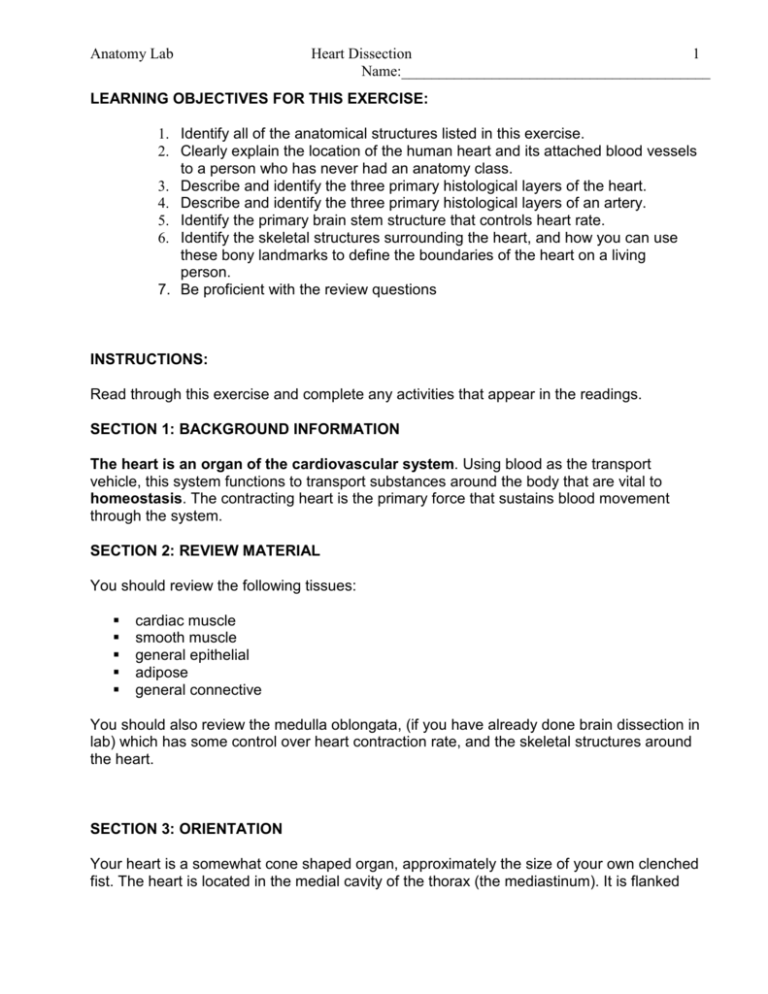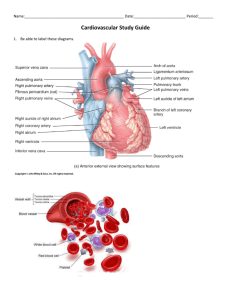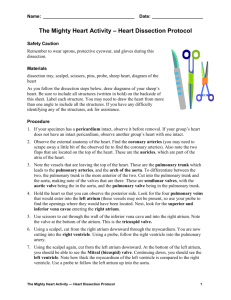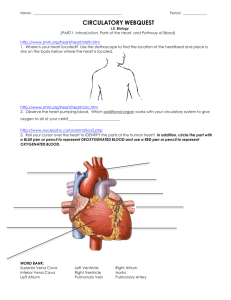Anatomy Lab Heart Dissection Name: 1 LEARNING OBJECTIVES
advertisement

Anatomy Lab Heart Dissection 1 Name:_________________________________________ LEARNING OBJECTIVES FOR THIS EXERCISE: 1. Identify all of the anatomical structures listed in this exercise. 2. Clearly explain the location of the human heart and its attached blood vessels to a person who has never had an anatomy class. 3. Describe and identify the three primary histological layers of the heart. 4. Describe and identify the three primary histological layers of an artery. 5. Identify the primary brain stem structure that controls heart rate. 6. Identify the skeletal structures surrounding the heart, and how you can use these bony landmarks to define the boundaries of the heart on a living person. 7. Be proficient with the review questions INSTRUCTIONS: Read through this exercise and complete any activities that appear in the readings. SECTION 1: BACKGROUND INFORMATION The heart is an organ of the cardiovascular system. Using blood as the transport vehicle, this system functions to transport substances around the body that are vital to homeostasis. The contracting heart is the primary force that sustains blood movement through the system. SECTION 2: REVIEW MATERIAL You should review the following tissues: cardiac muscle smooth muscle general epithelial adipose general connective You should also review the medulla oblongata, (if you have already done brain dissection in lab) which has some control over heart contraction rate, and the skeletal structures around the heart. SECTION 3: ORIENTATION Your heart is a somewhat cone shaped organ, approximately the size of your own clenched fist. The heart is located in the medial cavity of the thorax (the mediastinum). It is flanked Anatomy Lab Heart Dissection 2 Name:_________________________________________ laterally by the lungs, posteriorly by the vertebral column, and anteriorly by the sternum. The apex (lower point) of the heart extends slightly to the left of the body's midline and rests on the diaphragm around the area of the fifth intercostal space (between the fifth and sixth rib). The base (upper broad surface) of the heart lies just below the second rib and points towards the right shoulder. Usually, the lower right chamber (the right ventricle) of the heart rests towards the front of the thorax. SECTION 4: BASIC HEART ANATOMY AND BLOOD VESSELS You should be able to identify structures on illustrations, such as those found in your textbook and worksheets. If you can not identify all of your structures, then you should get out your textbook and worksheets and start memorizing them now. SECTION 5: ANATOMY OF AN ARTERY Arteries are conducting vessels that carry blood away from the heart. The walls Arteries are conducting vessels that carry blood away from the heart. The walls of arteries are constructed of three coats, or tunics. Starting outside and moving inward, the three "coats" are the tunica externa, the tunica media, and the tunica interna. The tunica externa is the outermost coat. This layer is composed of fibrous connective or areaolar tissue, and its primary function is to support and protect arteries. The tunica media is the bulky middle coat and is composed primarily of smooth muscle (and elastic tissue). This layer regulates the diameter of an artery, which in turn alters resistance and blood pressure. The tunica interna lines the lumen of an artery, and consists of a single layer of squamous cells. This layer of cells, along with its slight basement membrane, is called the endothelial layer. This endothelium is continuous with the endocardium, and is specialized to decrease resistance to blood flow. Vena Cava entrance to Right Atrium Aorta Pulmonary Artery Pulmonary veins return to Left Atrium Anatomy Lab Heart Dissection 3 Name:_________________________________________ SECTION 6: SHEEP HEART DISSECTION Here are the basic steps you should follow when dissecting the sheep heart: 1. Gather your dissection equipment and a sheep heart. 2. Rinse the sheep heart thoroughly with cold water to remove excess preservatives and to flush out blood clots. 3. Observe the pericardium. If the pericardial sac is intact then remove the outer layer from its attachment points. 4. Carefully pull the visceral pericardium (epicardium) away from the myocardium (follow the same procedure described in step 3). 5. Examine the external surface of the heart. Notice the accumulation of adipose tissue. This adipose usually accumulates along the boundaries of the heart chambers and along the coronary arteries. Remove as much adipose as possible. Now you should be able to identify the apex (bottom left "point" of the heart) and the auricles (earlike flaps projecting from the atria). 6. Locate the pulmonary trunk and the aorta on the superior aspect of the heart. Clear the adipose away from these arteries. The pulmonary trunk divides into the left and right pulmonary arteries. The aorta will have a large branch coming from beneath the pulmonary trunk. This branch is the right brachiocephalic artery. The right brachiocephalic artery divides into the right subclavian and the right common carotid arteries. Notice the three distinct layers of all these arteries. 7. Starting at the apex and moving towards the base, make a coronal (frontal) cut through the heart. Stop cutting when your knife reaches the top portions of the atria. 8. Open the heart at the apex. Now you should be able to identify the remaining structures on your Hot List. 9. Notice that the heart is made up of three histological layers: the epicardium (which is the same as the visceral pericardium), the myocardium (literally "heart muscle"), and the endocardium ("inside the heart"). Locate the side with the thickest myocardial wall. This will orient you to the left side of the heart. 10. You should see that there are spaces (or "chambers") on the left and right sides of the lower heart. These are the left and right ventricles ("vent" referring to something coming out of the space, which is blood in this case). 11. You should also see a thick structure dividing the two ventricles, the bulk of which is comprised of cardiac muscle. This is the interventricular septum. 12. The ventricles are divided from the chambers directly above them by atrioventricular (or "AV") valves. These valves have flaps (or "cusps") to which "heart strings" attach. The left AV valve had two cusps, so it can be referred to as being a "bicuspid" valve. The right valve has three cusps, so it can be referred to as being a "tricuspid" valve. Anatomy Lab Heart Dissection 4 Name:_________________________________________ 13. The strings that attach to the AV cusps are called chordae tendinea. 14. The chordae tendineae are anchored to the ventricular walls via papillary ("nipple-like") muscles. 15. You will need to cut through the rest of your heart in order to identify the remainder of the Hot List structures. 16. Note that you will need to remove the right ventricular wall and cut into the pulmonary trunk in order to view the pulmonary valve (or right semilunar valve). 17. Properly dispose of all organic materials and clean your dissecting tools and trays before leaving lab SECTION 7: EXPLORING VALVE ACTION If time allows, you can imitate blood flow through the heart and observe valve action be doing the following activity: 1. Obtain an intact heart and locate the superior vena cava (SVC). Use your scissors to cut along the walls of the SVC in order to open up the right atrium. Do not cut through the entire atrial wall. Only cut enough so you can see the interior of the chamber. 2. Observe the right A.V. valve (the right A.V. Valve has "three flaps" or is "tricuspid" in structure). 3. Slowly pour water into the right atrium and allow it to flow into the right ventricle. 4. Gently squeeze the right ventricle and watch the closing action of the right A.V. Valve WARNING: Do not squeeze the ventricle too roughly or too quickly. If you do then be prepared to have water squirted on your face, in your mouth, nose, eyes, etc. 5. Drain the water from the heart. 6. Now go to the pulmonary trunk and cut down the front of its wall until you see the pulmonary semilunar valve. 7. Pour some water into the pulmonary trunk so it runs towards the right ventricle. Observe the closing action of this valve. When you are done with this activity, answer the following question: How is the closing action of atrioventricular (cuspid) valves different from the closing action of semilunar valves? Anatomy Lab Heart Dissection 5 Name:_________________________________________ SECTION 8: REVIEW QUESTIONS The heart is an organ of this body system. ________________________ What is the muscular layer of the heart is called? ______________________ What is the name of the sac surrounding the heart? ____________________ What type of tissue comprises the bulk of the myocardium? ______________ What is the function of the heart? ___________________________________ ______________________________________________________________ 6. What is the function of an artery? ___________________________________ ______________________________________________________________ 7. From outermost to innermost, what are the three layers of an artery? ___________________________________________________________ 8. What is the function of a vein? _____________________________________ 9. What is the name of the space in a blood vessel wherein blood flows? _____________________________ 10. What is the lining of the heart called? ________________________________ 11. What is the primary brain stem structure that controls heart rate. _________________________________________ 12. What is the specific space in the thoracic cavity where the heart is located? ___________________________________________________________ 13. What bone protects the heart anteriorly? ___________________________ 14. The bulk of the heart rests on this side of the body. ___________________ 15. The pericardium attaches to this structure inferiorly. ___________________ 16. Which side of the heart as a thicker ventricular wall? ___________________ 17. What layer of an artery consists mostly of smooth muscle? _______________ 18. What chambers of the heart function to receive blood from the veins? _______________________________________ 19. The tunica interna is continuous with this layer of the heart. _________________________ 20. What part of the heart rests just below the right second rib? ________________________ 21. What are the bottom two chambers of the heart called? _________________ 22. What valves are located between the atria and the ventricles? ____________________________________________________________ 23. The apex of the heart points to this side of the body. ____________________ 24. What is the branch of the aorta that divides into the right subclavian and right common carotid arteries? _________________________________________ 25. What is the scientific term for the "heart strings" that extend from the AV cusps to the papillary muscles? ____________________________________ 26. What structure divides the two ventricles of the heart? __________________ 27. The superior vena cava attaches to this heart chamber. _________________ 28. What is the largest artery of the human body? _________________________ 29. What are the "ear-like" structures that extend from the atria? _____________ 30. The apex of the heart usually sits at the same approximate level as the space between these two ribs. __________________________________________ 1. 2. 3. 4. 5. Anatomy Lab Heart Dissection 6 Name:_________________________________________ SECTION 9: PRACTICE TESTS Test your knowledge with the following practice tests Real Heart Images Anatomy Lab Heart Dissection 7 Name:_________________________________________ The primary neural control of the heart originates in brain section (A / B / C). Choose one. The name of this brain section is the ____________________________________________. Anatomy Lab Heart Dissection 8 Name:_________________________________________ 1. What structure are the tweezers holding? ___________________________________ 2. The two thin leaflets circled make up the _______________________________ valve. 3. The beams and bridges circled are called __________________ ________ 4. These three leaflet structures make up what structure? ____________________________ Anatomy Lab Heart Dissection 9 Name:_________________________________________ 5. What are the small string like structures held by the tweezers? ___________________________________ 6. The chamber circled is the _____________ _________________________ Tag 1. The outer layer of the heart is the 7.________________________ Tag 2. The muscle mass is called the 8.________________________ Tag 3. The inner layer of the heart is called the 9.________________________ Anatomy Lab Heart Dissection 10 Name:_________________________________________ 10. The structure in the grasp of the tweezers is the ____________________________ valve. 11. The sheet-like structure being removed from the heart is the _____________________________________ Anatomy Lab Heart Dissection 11 Name:_________________________________________ 12. These three valve leaflets make up what valve? __________________________________ 13. This is another valve with similar structure to that above. What valve is it?__________________ Anatomy Lab Heart Dissection 12 Name:_________________________________________ Tag 1. 14. This muscle mass is the_________________ of the 15.________________ ventricle. Tag 2. This muscle mass is the intraventricular 16._____________________________ Tag 3. The ridges of tissue are called 17.________________ __________________ Tag 4. This is the 18.__________________________ valve. 19. The circled structure is the _________________ 20. Name the upper chamber: _____________________ 21. Name the Lower chamber: _____________________ 22. Name the three leaflet structure: _______________________ Anatomy Lab Heart Dissection 13 Name:_________________________________________ 23.The upper circled heart portion is called the _______________________ 24. The lower marked area is known as the: _______________________________ sulcus. 25. Name the upper chamber:___________ ____________________________ 26. Name the lower chamber: ___________ _____________________________ 27. The muscular protrusions into the chambers are called the _______________________ muscles.






